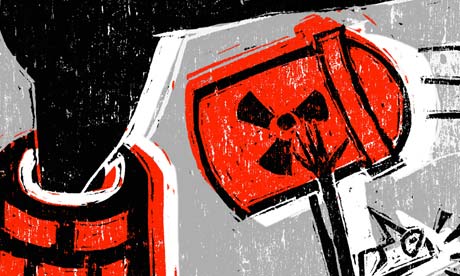SIDMOUTH BYES HYDRO
We are a group looking
to make the most of the weir on the River Sid near the Old Toll House on
Salcombe Road.
We are looking at
installing a weir and fish pass. The fish pass will benifit the whole Sid
Valley and the Hydro electricity produced will benifit a local school that is
situated next to the weir.
The group is in its
early stages and welcomes any advice or help.
Please email
FOTByes@gmail.com
Thank you.
Interestingly, there is the balance between provision of energy and looking after the fish.
On the other hand, George Monbiot, in his 'conversion' to nuclear energy, warns of the dangers of over-reliance on renewable energy sources:
Going Critical
March 21, 2011
How the Fukushima disaster taught me to
stop worrying and embrace nuclear power.
 Illustration: Daniel Pudles
Illustration: Daniel Pudles
By George Monbiot, published in the
Guardian 22nd March 2011
You will not be surprised to hear that the
events in Japan have changed my view of nuclear power. You will be surprised to
hear how they have changed it. As a result of the disaster at Fukushima, I am
no longer nuclear-neutral. I now support the technology.
Like most greens, I favour a major
expansion of renewables. I can also sympathise with the complaints of their
opponents. It’s not just the onshore windfarms that bother people, but also the
new grid connections (pylons and power lines).
Like others, I have called for renewable
power to be used both to replace the electricity produced by fossil fuel and to
expand the total supply, displacing the oil used for transport and the gas used
for heating fuel. Are we also to demand that it replaces current nuclear
capacity? The more work we expect renewables to do, the greater the impacts on
the landscape will be, and the tougher the task of public persuasion.
At
high latitudes like ours, most small-scale ambient power production is a dead
loss. Generating solar power in the UK involves a spectacular waste of scarce
resources(4,5). It’s hopelessly inefficient and poorly
matched to the pattern of demand. Wind power in populated areas is largely
worthless. This is partly because we have built our settlements in sheltered
places; partly because turbulence caused by the buildings interferes with the
airflow and chews up the mechanism. Micro-hydropower might work for a farmhouse
in Wales; it’s not much use in Birmingham.
And how do we drive our textile mills,
brick kilns, blast furnaces and electric railways – not to mention advanced
industrial processes? Rooftop solar panels? The moment you consider the demands
of the whole economy is the moment at which you fall out of love with local
energy production. A national (or, better still, international) grid is the
essential prerequisite for a largely renewable energy supply.
Some greens go even further: why waste
renewable resources by turning them into electricity? Why not use them to
provide energy directly? To answer this question, look at what happened in
Britain before the industrial revolution.
The damming and weiring of British rivers
for watermills was small-scale, renewable, picturesque and devastating. By
blocking the rivers and silting up the spawning beds, they helped bring to an
end the gigantic runs of migratory fish that were once among our great natural
spectacles and which fed much of Britain: wiping out sturgeon, lampreys and
shad as well as most seatrout and salmon(
Traction was intimately linked with
starvation. The more land that was set aside for feeding draft animals for
industry and transport, the less was available for feeding humans. It was the
17th-Century equivalent of today’s biofuels crisis. The same applied to heating
fuel. As EA Wrigley points out in his new book Energy and the English Industrial
Revolution, the 11 million tonnes of coal mined in England in 1800 produced as
much energy as 11 million acres of woodland (one third of the land surface)
would have generated.
Before
coal became widely available, wood was used not just for heating homes but also
for industrial processes: if half the land surface of Britain had been covered
with woodland, Wrigley shows, we could have made 1.25 million tonnes of bar
iron a year. Even with a much
lower population than today’s, manufactured goods in the land-based economy
were the preserve of the elite. Deep green energy production – decentralised,
based on the products of the land – is far more damaging to humanity than
nuclear meltdown.
But
the energy source to which most economies will revert if they shut down their
nuclear plants is not wood, water, wind or sun, but fossil fuel. On every
measure (climate change, mining impact, local pollution, industrial injury and
death, even radioactive discharges) coal is 100 times worse than nuclear power.
Thanks to the expansion of shale gas production, the impacts of natural gas are
catching up fast.
Yes, I still loathe the liars who run the
nuclear industry. Yes, I would prefer to see the entire sector shut down, if
there were harmless alternatives. But there are no ideal solutions. Every
energy technology carries a cost; so does the absence of energy technologies.
Atomic energy has just been subjected to one of the harshest of possible tests,
and the impact on people and the planet has been small. The crisis at Fukushima
has converted me to the cause of nuclear power.
.
.
.

No comments:
Post a Comment